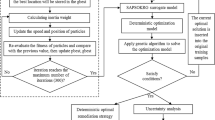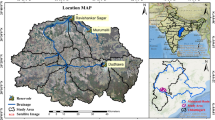Abstract
The Hydrological Tank model was used in this study to simulate the rainfall-runoff relationship in the Flint River basin near Carsonville, Georgia, USA. The model’s structure consisted of two tanks (upper and lower), and it depended primarily on a set of eight parameters to simulate daily stream flow components (surface, subsurface, and base flows) from daily precipitation while taking into account the effects of daily evapotranspiration, the water storage height, and the infiltration rate. The parameter set was calibrated, optimized, and validated with data spanning a period of 10 years (Oct. 1st, 2007–Sep. 30th, 2017). Model calibration and validation were performed by using the first and second 5-year periods of water flow data, respectively. The model performance was verified using the coefficient of determination (R2) and the Nash–Sutcliffe efficiency (NSE) coefficient. The results of one- and two-parameter sensitivity analyses showed that the model performance was highly dependent on the parameters Ko and K1 (the coefficients of the surface and subsurface flows, respectively). The Downhill Simplex Method (DSM) was used to find the optimum parameter set via the maximization of R2 and NSE. The optimum parameter set produced by maximizing the NSE values was adopted in this study because it produced a very good correlation between the simulated and observed stream flows for both the calibration and validation time periods. Using the adopted optimum parameter set, the maximum values of R2 and NSE were 0.818 and 0.812 in the calibration time period, respectively, and 0.756 and 0.750 in the validation time period, respectively. Moreover, the DSM has proven to be very reliable in locating global optimums and requires reasonable computational efforts in the calibration of a hydrological model.

(source: USGS)















Similar content being viewed by others
References
Beck MB, Kleissen FM, Wheater HS (1990) Identifying flow paths in models of surface water acidification. Rev Geophys 28(2):207–229. https://doi.org/10.1029/RG028i002p00207
Horsburgh JS, Morsy MM, Castronova AM, Goodall JL, Gan T, Yi H, Stealey MJ, Tarboton DG (2016) Hydroshare: sharing diverse environmental data types and models as social objects with application to the hydrology domain. JAWRA J Am Water Resour Assoc 52:873–889. https://doi.org/10.1111/1752-1688.12363
Kokkonen TS, Jakeman AJ (2001) A comparison of metric and conceptual approaches in rainfall-runoff modeling and its implications. Water Resour Res 37(9):2345–2352. https://doi.org/10.1029/2001WR000299
Leavesley GH (1994) Modeling the effects of climate change on water resources—a review. In Assessing the impacts of climate change on natural resource systems. Springer, Dordrecht: Chapter 8:159–177. https://doi.org/10.1007/978-94-011-0207-0_8
Jiang T, Chen YQ, Xu CY, Chen XH, Chen X, Singh VP (2007) Comparison of hydrological impacts of climate change simulated by six hydrological models in the Dongjiang Basin, South China. J Hydrol 336:316–333. https://doi.org/10.1016/j.jhydrol.2007.01.010
Yang J, Reichert P, Abbaspour KC, Xia J, Yang H (2008) Comparing uncertainty analysis techniques for a SWAT application to the Chaohe Basin in China. J Hydrol 358:1–23. https://doi.org/10.1016/j.jhydrol.2008.05.012
Shen Z, Chen L, Hong Q, Qiu J, Xie H, Liu R (2013) Assessment of nitrogen and phosphorus loads and causal factors from different land use and soil types in the Three Gorges Reservoir Area. Sci Total Environ 454:383–392. https://doi.org/10.1016/j.scitotenv.2013.03.036
Blöschl G, Sivapalan M (1995) Scale issues in hydrological modelling: a review. Hydrol Process 9:251–290. https://doi.org/10.1002/hyp.3360090305
Wang XL, Swail VR, Cox A (2010) Dynamical versus statistical downscaling methods for ocean wave heights. Int J Climatol J R Meteorol Soc 30:317–332. https://doi.org/10.1002/joc.1899
Vieux BE, Cui Z, Gaur A (2004) Evaluation of a physics-based distributed hydrologic model for flood forecasting. J Hydrol 298:155–177. https://doi.org/10.1016/j.jhydrol.2004.03.035
Vaze J, Jordan P, Beecham R, Frost A, Summerell G (2012) Guidelines for rainfall-runoff modeling-towards best practice model application. Water Research Cooperation, Bruce, ACT. https://ewater.org.au/uploads/files/eWater-Guidelines-RRM-(v1_0-Interim-Dec-2011).pdf. Accessed 20 Apr 2020
Jaiswal RK, Ali S, Bharti B (2020) Comparative evaluation of conceptual and physical rainfall–runoff models. Appl Water Science 10:1–14. https://doi.org/10.1007/s13201-019-1122-6
Suryoputro N, Suhardjono, Soetopo W, Suhartanto E (2017) Calibration of infiltration parameters on hydrological tank model using runoff coefficient of rational method. In: AIP conference proceedings, AIP Publishing 1887:020056. https://doi.org/10.1063/1.5003539
Sugawara M (1979) Automatic calibration of the tank model/L'étalonnage automatique d'un modèle à cisterne. Hydrol Sci Bull 24:375–388. https://doi.org/10.1080/02626667909491876
Mizumura K (1995) Runoff prediction by simple tank model using recession curves. J Hydraulic Eng 121:812–818. https://doi.org/10.1061/(ASCE)0733-9429(1995)121:11(812)
Nagasaka A, Nakamura F (1999) The influences of land-use changes on hydrology and riparian environment in a northern Japanese landscape. Landsc Ecol 14:543–556. https://doi.org/10.1023/A:1008164123102
Yue S, Hashino M (2000) Unit hydrographs to model quick and slow runoff components of streamflow. J Hydrol 227:195–206. https://doi.org/10.1016/S0022-1694(99)00185-7
Yokoo Y, Kazama S, Sawamoto M, Nishimura H (2001) Regionalization of lumped water balance model parameters based on multiple regression. J Hydrol 246:209–222. https://doi.org/10.1016/S0022-1694(01)00372-9
Hong Y, Hiura H, Shino K, Sassa K, Fukuoka H (2005) Quantitative assessment on the influence of heavy rainfall on the crystalline schist landslide by monitoring system-case study on Zentoku landslide, Japan. Landslides 2:31–41. https://doi.org/10.1007/s10346-005-0044-6
Fumikazu N, Toshisuke M, Yoshio H, Hiroshi T, Kimihito N (2013) Evaluation of water resources by snow storage using water balance and tank model method in the Tedori River basin of Japan. Paddy Water Environ 11:113–121. https://doi.org/10.1007/s10333-011-0297-8
Hong N, Hama T, Suenaga Y, Aqili SW, Huang X, Wei Q, Kawagoshi Y (2016) Application of a modified conceptual rainfall–runoff model to simulation of groundwater level in an undefined watershed. Sci Total Environ 541:383–390. https://doi.org/10.1016/j.scitotenv.2015.09.026
May R, Zainol Z, Shukor MFB (2015) Flood frequency analysis due to climate change condition at the Upper Klang River basin. In: ISFRAM 2014. Springer, Singapore, pp 271–281. https://doi.org/10.1007/978-981-287-365-1_22
Abdulkareem JH, Pradhan B, Sulaiman WNA, Jamil NR (2018) Review of studies on hydrological modelling in Malaysia. Model Earth Syst Environ 4:1577–1605. https://doi.org/10.1007/s40808-018-0509-y
Faris F, Fathani F (2013) A coupled hydrology/slope kinematics model for developing early warning criteria in the Kalitlaga Landslide, Banjarnegara, Indonesia. In Progress of geo-disaster mitigation technology in Asia. Springer, Berlin, pp 453–467
Nielsen GL, Widjaya JM (1989) Modeling of ground-water recharge in Southern Bali, Indonesia. Groundwater 27:473–480. https://doi.org/10.1111/j.1745-6584.1989.tb01967.x
Sadeghi SHR, Jalili K, Nikkami D (2009) Land use optimization in watershed scale. Land Use Policy 26:186–193. https://doi.org/10.1016/j.landusepol.2008.02.007
Chadalawada J, Havlicek V, Babovic V (2017) A genetic programming approach to system identification of rainfall-runoff models. Water Resour Manag 31:3975–3992. https://doi.org/10.1007/s11269-017-1719-1
Chen J, Adams BJ (2006) Integration of artificial neural networks with conceptual models in rainfall-runoff modeling. J Hydrol 318:232–249. https://doi.org/10.1016/j.jhydrol.2005.06.017
Al-Abed N, Al-Sharif M (2008) Hydrological modeling of Zarqa River basin–Jordan using the hydrological simulation program–FORTRAN (HSPF) model. Water Resour Manag 22:1203–1220. https://doi.org/10.1007/s11269-007-9221-9
Chen RS, Pi LC, Hsieh CC (2005) Application of parameter optimization method for calibrating tank model 1. JAWRA J Am Water Resour Assoc 41:389–402. https://doi.org/10.1111/j.1752-1688.2005.tb03743.x
Cooper VA, Nguyen VTV, Nicell JA (2007) Calibration of conceptual rainfall–runoff models using global optimisation methods with hydrologic process-based parameter constraints. J Hydrol 334:455–466. https://doi.org/10.1016/j.jhydrol.2006.10.036
Amiri BJ, Fohrer N, Cullmann J, Hörmann G, Müller F, Adamowski J (2016) Regionalization of tank model using landscape metrics of catchments. Water Resour Manag 30:5065–5085. https://doi.org/10.1007/s11269-016-1469-5
Singh S, Srivastava P, Abebe A, Mitra S (2015) Baseflow response to climate variability induced droughts in the Apalachicola–Chattahoochee–Flint River Basin, USA. J Hydrol 528:550–561. https://doi.org/10.1016/j.jhydrol.2015.06.068
Case JL, Zavodsky BT (2018) Evolution of 2016 drought in the Southeastern United States from a Land surface modeling perspective. Results Phys 8:654–656. https://doi.org/10.1016/j.rinp.2017.12.029
NASA https://power.larc.nasa.gov/data-access-viewer/?fbclid=IwAR1gVVK6FgaLg3vlOdmtMhtkEHfByZ1GbaHwPEGj5qu. Accessed 12 Apr 2020
USGS https://waterdata.usgs.gov/ga/nwis/uv/?site_no=02347500&PARAmeter_cd=00065,00060,00062. Accessed 12 Apr 2020
Bormann H (2011) Sensitivity analysis of 18 different potential evapotranspiration models to observed climatic change at German climate stations. Clim Change 104:729–753. https://doi.org/10.1007/s10584-010-9869-7
Jakimavičius D, Kriaučiūnienė J, Gailiušis B, Šarauskienė D (2013) Assessment of uncertainty in estimating the evaporation from the Curonian Lagoon. BALTICA 26(2):177–186. https://doi.org/10.5200/baltica.2013.26.18
Sugawara M (1967) The flood forecasting by a series storage type model. In: International symposium on floods and their computation, pp 555–560. Publication No. 84. International Association of Scientific Hydrology, UNESCO. https://hydrologie.org/redbooks/a084/084062.pdf. Accessed 8 Apr 2020
Nelder JA, Mead R (1965) A simplex method for function minimization. Comput J 7:308–313. https://doi.org/10.1093/comjnl/7.4.308
Cooper VA, Nguyen VT, Nicell JA (1997) Evaluation of global optimization methods for conceptual rainfall-runoff model calibration. Water Sci Technol 36(5):53–60. https://doi.org/10.1016/S0273-1223(97)00461-7
Escurra JJ (2008) Optimal irrigation management for sloping blocked-end borders. Doctor of Philosophy (PhD) Dissertation. Utah State University. Department: Biological and Irrigation Engineering. 214. https://digitalcommons.usu.edu/etd/214
Moriasi DN, Arnold JG, Van Liew MW, Bingner RL, Harmel RD, Veith TL (2007) Model evaluation guidelines for systematic quantification of accuracy in watershed simulations. Trans ASABE 50(3):885–900. https://doi.org/10.13031/2013.23153
Qi Z, Kang G, Chu C, Qiu Y, Xu Z, Wang Y (2017) Comparison of SWAT and GWLF model simulation performance in humid south and semi-arid north of China. Water 9:567. https://www.mdpi.com/2073-4441/9/8/567/pdf. Accessed 20 June 2020
Nash JE, Sutcliffe JV (1970) River flow forecasting through conceptual models part I—A discussion of principles. J Hydrol 10:282–290. https://doi.org/10.1016/0022-1694(70)90255-6
Legates DR, McCabe GJ Jr (1999) Evaluating the use of “goodness-of-fit” measures in hydrologic and hydroclimatic model validation. Water Resour Res 35:233–241. https://doi.org/10.1029/1998WR900018
Acknowledgements
The authors are grateful to the University of Basrah for providing the facilities necessary for this study. Special thanks to Professor Hoshin V. Gupta for providing the DSM program.
Author information
Authors and Affiliations
Corresponding author
Ethics declarations
Conflict of interest
On behalf of all authors, the corresponding author states that there are no conflicts of interest.
Rights and permissions
About this article
Cite this article
Al-Asadi, K., Abbas, A.A. & Hamdan, A.N. Optimization of the Hydrological Tank Model by Downhill Simplex Method. Int J Civ Eng 18, 1433–1450 (2020). https://doi.org/10.1007/s40999-020-00540-5
Received:
Revised:
Accepted:
Published:
Issue Date:
DOI: https://doi.org/10.1007/s40999-020-00540-5




